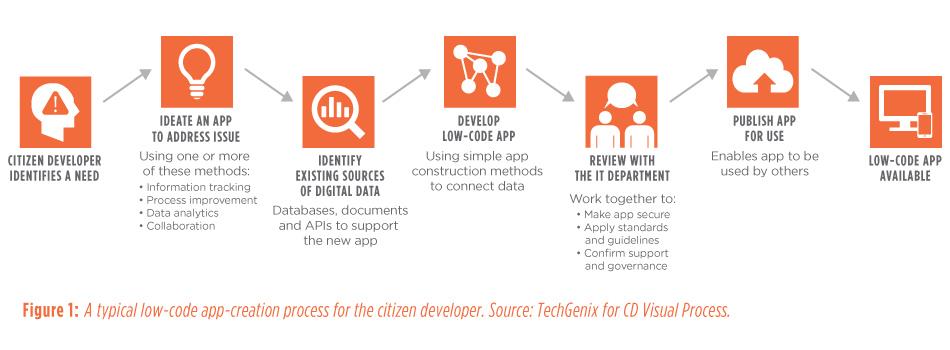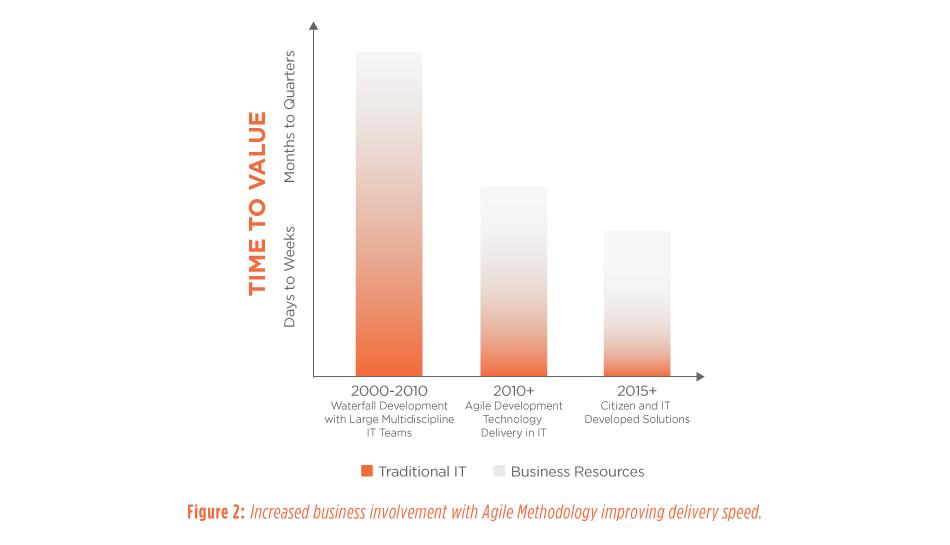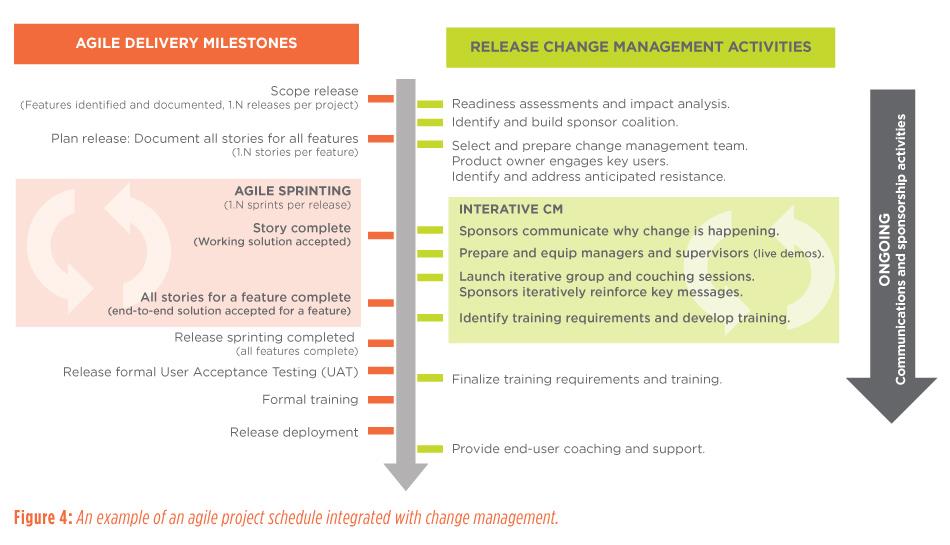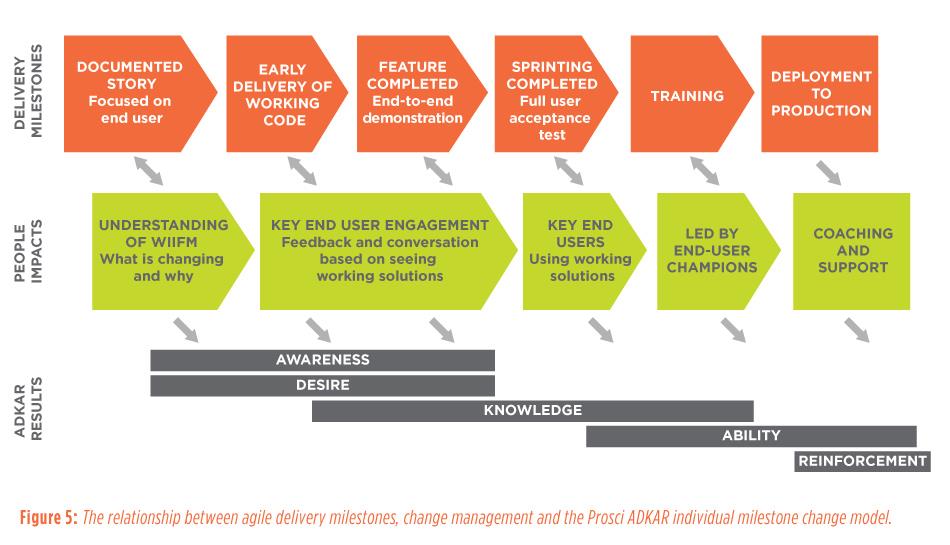
Utilizing the most effective delivery process — including the role of citizen developers — is the key to capturing this value. By combining an agile methodology with people change management, companies can maximize the return on investment while minimizing delays and inefficiencies.
Many businesses are configuring and administering technical solutions like Oracle Aconex and Hexagon PPM EcoSys independent of IT. Others are leveraging low-code solutions, like Microsoft Power Apps and Hexagon PPM Xalt, to extend the life span and impact of homegrown Microsoft Excel‑based solutions.
With the proliferation of digital solutions — and the growing size of the teams who typically support them — many businesses are recognizing the need for integrating agile project delivery and people change management into the execution of these solutions. Without this combined approach, companies risk the possibility of their projects becoming a negative statistic, as, according to the Project Management Institute, over the past decade one-third of projects fail to meet goals and one-half aren’t completed on time.
Read The White Paper

Utilizing the most effective delivery process — including the role of citizen developers — is the key to capturing this value. By combining an agile methodology with people change management, companies can maximize the return on investment while minimizing delays and inefficiencies.
Many businesses are configuring and administering technical solutions like Oracle Aconex and Hexagon PPM EcoSys independent of IT. Others are leveraging low-code solutions, like Microsoft Power Apps and Hexagon PPM Xalt, to extend the life span and impact of homegrown Microsoft Excel‑based solutions.
With the proliferation of digital solutions — and the growing size of the teams who typically support them — many businesses are recognizing the need for integrating agile project delivery and people change management into the execution of these solutions. Without this combined approach, companies risk the possibility of their projects becoming a negative statistic, as, according to the Project Management Institute, over the past decade one-third of projects fail to meet goals and one-half aren’t completed on time.
When implementing technology, utilizing the most effective delivery process is key to stakeholder engagement and end-user adoption. As IT departments pursue more effective project delivery, there has been a systematic shift over the last decade from the traditional waterfall approach to various agile approaches.
Agile software development, as defined by the Agile Alliance, is “a set of methods and practices where solutions evolve through collaboration between self-organizing, cross-functional teams.” It emphasizes continual planning, regular collection of feedback, ongoing learning and incremental delivery.
This approach has achieved mixed success, due in part to a focus on technology delivery without the inclusion of sound people change management practices. Specifically, bringing people change management into the agile delivery process allows more employees to fully and correctly utilize new software and processes faster — thereby capturing the maximum business value while minimizing the potential negative side effects of change. This becomes even more apparent as companies continue to empower, embrace and utilize citizen developers (CDs).
Role of Citizen Development Teams
CDs are not developers by trade or title, but rather can be anyone in the business, from a manager in the finance department to an analyst who takes the initiative to develop his or her own application using development software and platforms sanctioned by the IT department. Years ago, some might have referred to CDs as shadow IT teams, doing critical work out of sight of the IT department.
Due to digital transformations and cloud migrations, the workload of IT teams has increased, and, in many organizations, the IT department tends to be understaffed and overworked. Yet the digital ecosystem — such as cloud-based, legacy, on-premise and hybrid solutions that require increasing interconnectivity, as well as AI and bots — grows more complex every day. From this sea of necessity rises the criticality of the CD.
CD solutions can be found everywhere, from complicated solutions that handle resource management or forecasts to increasingly sophisticated self-service analytics and a variety of business process management, communication and collaboration tools that empower day-to-day operations. Over time, the number and impact of CD-owned solutions has grown due to the proliferation of federated cloud applications and data and the increasing number of distinct technologies and applications involved in running day-to-day operations. This, in turn, has been fueled by the increase of business self-service-oriented software, which has put more power directly in the hands of the business.
Given the necessity to empower CD teams in today’s technology-rich environment — while recognizing the enterprise risk in terms of security and resiliency — IT departments have shifted to guiding and reviewing the technologies that CDs will use and implementing policies designed to balance empowerment, security and cost. In this way, IT departments are transforming themselves and focusing more on orchestrating technology vendors and guiding CDs. While there are some concerns regarding compliance mandates and other controls that CDs may not be equipped to address on their own, CDs represent a creative force that — if understood and leveraged by forward-thinking organizations — can be a boon.
Enterprisewide Digital Transformations Benefit From CDs
CDs can also be useful in driving digital transformation throughout an organization. Through their use of low-code/no-code technologies, CDs can use visual modeling to easily build efficient applications and solutions in a matter of days instead of months. The business insight of CDs means they know more about their internal procedures and standards than an external team would, enabling them to more quickly bridge business needs to digital realities.
Thus, considering CDs within an enterprisewide digital transformation strategy helps maintain the competitive edge in digital initiatives. While the agile revolution has helped improve delivery quality and speed to market, organizations are recognizing that incorporating CDs into digital initiatives increases delivery time and saves money by reducing delivery team size. Figure 2 shows how the speed to realize benefits has decreased over time due to agile delivery and the shift from business team members being agile product owners to now being directly involved in technical configuration as CDs.
CDs generally choose to use familiar and accessible applications to come up with a solution to an existing problem in the workplace. Success begets further success, as colleagues appreciate the value of the solution and recognize how the solutions could be enhanced or adapted to resolve existing problems in other parts of the organization. This brings CDs to the realization of what IT has dealt with for decades: multiple stakeholders with conflicting priorities and a set of end users who may not want to change their day-to-day routine. This transition from team-level solutions — often supported by one person — to department or even enterpriselevel solutions supported by technology teams within the business requires CD teams to employ people change management and agile delivery processes.
The Renewed Need for Agile Delivery
While the agile methodology encompasses frameworks like scrum and extreme programming, it is not limited to them. Rather, it is an umbrella term for a set of practices based on the values stated in the Agile Alliance’s Agile Manifesto, some of which dovetail directly into the core principles of people change management:
- Individuals and interactions over processes and tools.
- Working software over comprehensive documentation.
- Customer collaboration over contract negotiation.
- Responding to change over following a plan.
Agile methodologies typically divide project scope into small pieces of work aligned with business objectives and end users. Delivery to the customer is determined by priorities and dependencies and is scheduled in planned intervals, typically of one to three weeks. In scrum-based methodologies, each piece of work is known as a “story” and each delivery interval is a “sprint.”
Stories are meant to capture key details from conversations with stakeholders. They are written in business language, rather than technical jargon, to avoid creating misunderstandings or mental blocks. Stories attempt to answer the following questions:
- Who will be impacted?
- What do they require?
- Why do they care? (Or, what benefit will be received?)
However, there are many variants of agile methodology and no single approach will work for every project.
Benefits of an Agile Approach
Technology projects face unpredictable challenges. Many stakeholders can’t visualize features until they see them in real-life demonstrations, so it is unrealistic to expect them to accurately communicate the full product to developers in advance. While CD teams have an advantage given their local business acumen — especially for local team solutions — this advantage evaporates as the scope of the solution expands to enterprise levels.
Agile methodology addresses the reality that stakeholders may change their minds and redefine features. It accepts that scope, need and solution cannot be fully understood or defined upfront and instead focuses on how to maximize the team’s ability to deliver quickly and respond to current needs. Agile project delivery offers many benefits, including:
- Increased stakeholder engagement. Agile methodology puts the end users of the product front and center throughout the development process. Due to the structure of a story, agile delivery quickly establishes awareness and desire for the finished product. Because the agile process is inherently transparent, it fosters collaborative engagement and conversation with all stakeholders — both the ones CDs have close relationships with, and those in other departments that will now depend on new CD solutions.
- Responsive control. Agile delivery empowers team members to effectively manage and adapt to change, including dynamic business demands. Due to the predictability and granularity of scope, cost and schedule, agile methods allow both management and delivery teams to exercise fine-grained, rapid change.
- Speed to value and maximum return on investment (ROI). In the agile approach, functionality that delivers the most value is delivered first. Delivery is focused on end users, thereby maximizing adoption and utilization.
- Reduced risk. With a focus on delivering a working product rapidly and in collaboration with stakeholders, leadership can focus on what is working and make timely decisions to change what isn’t.
- Enhanced product quality. Frequent delivery of working functionality identifies gaps in understanding and expectations early. Thoughtful, fine-grained adjustments to scope deliver timely functionality and empower users sooner.
In addition, investing in an agile approach improves a project team’s capacity to implement more and better process improvements over time. As the team becomes more competent with agile methodologies, it can deliver continuous improvement both in execution and in end results.
Limitations of Agile Delivery
Though agile delivery offers many benefits, a word of caution is in order. It’s possible to execute an agile approach ineffectively, especially when the practitioners — such as CDs — are not inherently sensitive to the challenges of keeping a variety of stakeholders aligned. Scope and schedule may change; requirements and decisions can be deferred; formal project governance, controls and oversight can be forgotten; and the creation of documentation that is required for alignment and support can be deprioritized.
Pragmatic and consistent adoption of the key concepts and principles of agile delivery are essential and more important even than choosing the “best” agile delivery variant. As stated in the Agile Manifesto, individuals and interactions must take priority, and embedded CDs foster and encourage those interactions. Agile delivery requires collaboration throughout, with end users and stakeholders.
Ultimately, with or without CDs, agile delivery is a means to an end characterized by less friction, increased efficiency, and a solution embraced and adopted by the business. Organizations cannot lose sight of that end — and that is where people change management comes in.
Intersection With People Change Management
Organizational change management (OCM), or organizational development (OD), is a commonly understood concept. That is, businesses know these ideas as a framework or collection of approaches for managing the implementation of new business processes or technology tools, or for changing organizational structure or process. But organizations don’t change — people do.
Because organizations are composed of people and their work, OCM is more aptly named “people change management” or some variation that keeps people at the forefront. The goal of change managers is to prepare, equip and support people through change journeys.
According to Prosci Inc. — a global leader in change management — adoption is achieved when employees are doing their job in a new way. They are adhering to new processes, exhibiting new behavior, and using new systems and tools. Usage is achieved when employees are effective in their adoption, showing proficiency with minimal errors.
Natural Synergies
Within an agile development approach, change management becomes iterative. The process of change stays the same in that individuals, and thus teams, start at a current state, move through a transition state and arrive at the desired future state. However, in agile development this process happens within each development sprint cycle.
At a project level, change management plans become living documents open to rapid iterations and adjustments. Change management must be done in less time and at a faster pace. Because agile delivery involves a degree of uncertainty, flexibility is key. Figure 4 illustrates how change management activities are integrated with release-level agile milestones.
These activities are then mapped to the ADKAR model. ADKAR defines the five outcomes individuals need to achieve for lasting change: awareness, desire, knowledge, ability and reinforcement.
CDs are integrated stakeholders benefiting from the ADKAR milestones. They should not be ignored but embraced as both potential super users and advocates of digital transformation changes within their operational area. CDs become strong advocates within the network of change champions, especially when they have contributed to the solution.
To maximize the value of any digital transformation effort, companies should prioritize purposeful people change management and cement the process with reinforcement tasks, such as measurement, gap analysis/fill and incentivizing, to prevent reversion back to old ways. After all, organizations are simply a construct of the activities and plans of people. The task of organizing a network of change champions is one of the first steps in people change management. Having a well-developed network of CDs as super users speeds up this process.
Achieving Business Objectives
When organizations invest in new tools and processes, business leaders typically have three key priorities:
- Get it done. Implement an effective project delivery process to see that the change is developed, delivered and implemented on time.
- Achieve full adoption. Make sure 100% of users can and do use the new tool or process as quickly as possible to minimize the cost of adoption.
- Preserve the brain trust. Get buy-in from key employees so they will be invested in making the change successful and will remain with the company throughout the transition and beyond.
CDs help with all of the above, delivering high-quality, effective digital solutions; championing and leading adoption of enterprise initiatives; and not only preserving human capital, but providing key resources for growth opportunities.
Clearly defining these priorities allows a business to shape a successful change strategy. Nevertheless, change management can be viewed as an afterthought when it comes to agile execution. Organizations can become too focused on the agile process and grow disconnected from the end user and impactful delivery. This reaction is evidenced in failed digital transformation projects that ignore the power of organizing and supporting the CDs.
Conclusion
Agile and people change management are two complementary disciplines designed on the same principles and are created to bring about increased ROI with a reduction of development friction and implementation pain. Both have a formal structure with enough overlap and integration points to see the most complex digital transformation succeed, particularly when coupled with the power of CDs.
CDs grew out of a strong desire for change. This practice should be guided and empowered with structured methodologies that solidify adoption and usage of the digital products they produce. CDs have real strategic power to drive digital transformations across entire organizations. IT professionals and business leaders must engage their change management muscles to empathize, understand and harness this creative power. Working with a partner who can provide business, agile delivery and technical know-how, coupled with change management experience, provides the full set of synergistic skills required to support CDs and maximize their business impact.









